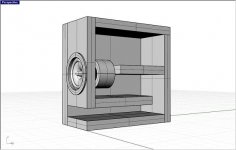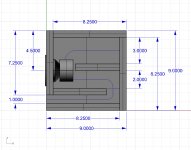purplepeople said:I've got one for the W3-593s. It is OD 9" x 9" x 5" using cheap 3/4" board. The line is about 24" long.
I'm still working on the BSC circuit so it is not finished but hooked up to the old Philips AG9016 that my Dad gave me, it sounds great. Not deep bass, but lots of it. When it's done, it will get posted.
ensen.
purplepeople:
any update on this design?, I have W3-595s in idle and want to try a small box with some bass.
gychang
I have a pair of Hivi F5BN drivers.
http://www.swanspeaker.com/product/htm/view.asp?id=69
Is this driver suitable for a TL design? Would someone suggest me a simple TL design?
I know how to compute cabinet height (70cm?) and the length of the length of TML duct (130cm?), but I don't know hot to compute the taper, So/Sd parameters (box volume), etc.
Thanks for help.
http://www.swanspeaker.com/product/htm/view.asp?id=69
Is this driver suitable for a TL design? Would someone suggest me a simple TL design?
I know how to compute cabinet height (70cm?) and the length of the length of TML duct (130cm?), but I don't know hot to compute the taper, So/Sd parameters (box volume), etc.
Thanks for help.
How is it?
I have W3-593 and need 2 small PC speakers. I know this is old thread, anyone have any input? I like the size and simple build. Port size?
thanks,
gychang
I've got one for the W3-593s. It is OD 9" x 9" x 5" using cheap 3/4" board. The line is about 24" long.
I'm still working on the BSC circuit so it is not finished but hooked up to the old Philips AG9016 that my Dad gave me, it sounds great. Not deep bass, but lots of it.
ensen.
I have W3-593 and need 2 small PC speakers. I know this is old thread, anyone have any input? I like the size and simple build. Port size?
thanks,
gychang
Attachments
Last edited:
Actually, I did end up building this speaker some years ago and used them on my office computer until gifting them before moving cross country in 2007. I still regret not taking photos before letting them go.
That said, it's a fairly easy build using typical 1x4 pine, which actually measures 3/4" x 3-1/2" in profile. The side panels are 1x10 pine trimmed to 9"x9". No glue at all... just 82 drywall screws. Each panel is held on with 18 screws positioned so that each 1x4 gets a screw in the middle and one at each end. Every butt joint gets one screw for a total of 41 screws per speaker. With fairly straight and flat boards, the seams are so well sealed that you can hear the low end come alive the moment the second panel is screwed down.
Stuffing only fills the first 2/3 of the line and is cut from some fuzzy polyester blanket bought at a discount store. I tried to fill only the first 1/3 but the driver's rear output was leaking and making it sound a little hollow. I don't know the material density or the total weight of stuffing as it was added or subtracted over a couple hours of listening tests.
The final amp board was ripped out of a pair of cheap computer speakers and screwed to the back of one of the "left" unit. The wiring to each driver snaked in through the front vent. Not pretty, but no drilling or worry about holes messing up the internal seal. Compared to my heirloom tube amp, this circuit is even close to the power handling of the Tangbands, but more than enough when sitting in front of a computer monitor. Still no BSC, but I used the media player EQ set to flat below 1kHz and between -3dB and -6dB above.
Sound was very rich when hooked up to the Philips AG9016 even when using the tone controls as crude BSC. Surprising amounts of oomph. When using the cheap PC speaker amp, there was more noise and less low end but the results were still surprising. The lucky recipient is a relative who is trained as an audio engineer. Even he was surprised by them and said that even with their shortcomings, they were more accurate than many small control room satellites he's heard.
 ensen.
ensen.
PS: Here's a side view cutaway with dimensions. The internal width is 3-1/2" to match the stock pine boards for an overall width is 5 inches.
That said, it's a fairly easy build using typical 1x4 pine, which actually measures 3/4" x 3-1/2" in profile. The side panels are 1x10 pine trimmed to 9"x9". No glue at all... just 82 drywall screws. Each panel is held on with 18 screws positioned so that each 1x4 gets a screw in the middle and one at each end. Every butt joint gets one screw for a total of 41 screws per speaker. With fairly straight and flat boards, the seams are so well sealed that you can hear the low end come alive the moment the second panel is screwed down.
Stuffing only fills the first 2/3 of the line and is cut from some fuzzy polyester blanket bought at a discount store. I tried to fill only the first 1/3 but the driver's rear output was leaking and making it sound a little hollow. I don't know the material density or the total weight of stuffing as it was added or subtracted over a couple hours of listening tests.
The final amp board was ripped out of a pair of cheap computer speakers and screwed to the back of one of the "left" unit. The wiring to each driver snaked in through the front vent. Not pretty, but no drilling or worry about holes messing up the internal seal. Compared to my heirloom tube amp, this circuit is even close to the power handling of the Tangbands, but more than enough when sitting in front of a computer monitor. Still no BSC, but I used the media player EQ set to flat below 1kHz and between -3dB and -6dB above.
Sound was very rich when hooked up to the Philips AG9016 even when using the tone controls as crude BSC. Surprising amounts of oomph. When using the cheap PC speaker amp, there was more noise and less low end but the results were still surprising. The lucky recipient is a relative who is trained as an audio engineer. Even he was surprised by them and said that even with their shortcomings, they were more accurate than many small control room satellites he's heard.
PS: Here's a side view cutaway with dimensions. The internal width is 3-1/2" to match the stock pine boards for an overall width is 5 inches.
Attachments
Last edited:
Actually, I did end up building this speaker some years ago and used them on my office computer until gifting them before moving cross country in 2007. I still regret not taking photos before letting them go.
That said, it's a fairly easy build using typical 1x4 pine, which actually measures 3/4" x 3-1/2" in profile. The side panels are 1x10 pine trimmed to 9"x9". No glue at all... just 82 drywall screws. Each panel is held on with 18 screws positioned so that each 1x4 gets a screw in the middle and one at each end. Every butt joint gets one screw for a total of 41 screws per speaker. With fairly straight and flat boards, the seams are so well sealed that you can hear the low end come alive the moment the second panel is screwed down.
Stuffing only fills the first 2/3 of the line and is cut from some fuzzy polyester blanket bought at a discount store. I tried to fill only the first 1/3 but the driver's rear output was leaking and making it sound a little hollow. I don't know the material density or the total weight of stuffing as it was added or subtracted over a couple hours of listening tests.
The final amp board was ripped out of a pair of cheap computer speakers and screwed to the back of one of the "left" unit. The wiring to each driver snaked in through the front vent. Not pretty, but no drilling or worry about holes messing up the internal seal. Compared to my heirloom tube amp, this circuit is even close to the power handling of the Tangbands, but more than enough when sitting in front of a computer monitor. Still no BSC, but I used the media player EQ set to flat below 1kHz and between -3dB and -6dB above.
Sound was very rich when hooked up to the Philips AG9016 even when using the tone controls as crude BSC. Surprising amounts of oomph. When using the cheap PC speaker amp, there was more noise and less low end but the results were still surprising. The lucky recipient is a relative who is trained as an audio engineer. Even he was surprised by them and said that even with their shortcomings, they were more accurate than many small control room satellites he's heard.
ensen.
PS: Here's a side view cutaway with dimensions. The internal width is 3-1/2" to match the stock pine boards for an overall width is 5 inches.
this is very helpful, thanks.
- Status
- This old topic is closed. If you want to reopen this topic, contact a moderator using the "Report Post" button.

